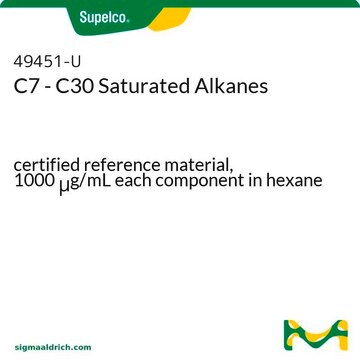47660-U
Dibromoacetic acid solution
certified reference material, 1000 μg/mL in methyl tert-butyl ether
About This Item
Prodotti consigliati
Grado
certified reference material
TraceCERT®
agenzia
EPA 552.2
Nome Commerciale
TraceCERT®
CdA
current certificate can be downloaded
Caratteristiche
standard type calibration
Confezionamento
ampule of 1 mL
Concentrazione
1000 μg/mL in methyl tert-butyl ether
tecniche
HPLC: suitable
gas chromatography (GC): suitable
applicazioni
environmental
Formato
single component solution
Temperatura di conservazione
2-8°C
InChI
1S/C2H2Br2O2/c3-1(4)2(5)6/h1H,(H,5,6)
SIEILFNCEFEENQ-UHFFFAOYSA-N
Applicazioni
Altre note
Note legali
Avvertenze
Warning
Indicazioni di pericolo
Classi di pericolo
Skin Irrit. 2
Codice della classe di stoccaggio
3 - Flammable liquids
Classe di pericolosità dell'acqua (WGK)
WGK 1
Punto d’infiammabilità (°F)
Not applicable
Punto d’infiammabilità (°C)
Not applicable
Dispositivi di protezione individuale
Eyeshields, Faceshields, Gloves, type ABEK (EN14387) respirator filter
Scegli una delle versioni più recenti:
Possiedi già questo prodotto?
I documenti relativi ai prodotti acquistati recentemente sono disponibili nell’Archivio dei documenti.
Il team dei nostri ricercatori vanta grande esperienza in tutte le aree della ricerca quali Life Science, scienza dei materiali, sintesi chimica, cromatografia, discipline analitiche, ecc..
Contatta l'Assistenza Tecnica.
